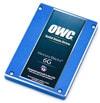 OWC announced the Electra SSD in June as a mainstream companion to their enthusiast-class SSD Mercury Extreme Pro 6G. The Electra features the SandForce SF-2281 processor and Intel/Micron 25nm asynchronous NAND which combine with a SATA 6Gb/s interface to deliver sequential reads up to 556MB/s and writes up to 523MB/s.
OWC announced the Electra SSD in June as a mainstream companion to their enthusiast-class SSD Mercury Extreme Pro 6G. The Electra features the SandForce SF-2281 processor and Intel/Micron 25nm asynchronous NAND which combine with a SATA 6Gb/s interface to deliver sequential reads up to 556MB/s and writes up to 523MB/s.
OWC announced the Electra SSD in June as a mainstream companion to their enthusiast-class SSD Mercury Extreme Pro 6G. The Electra features the SandForce SF-2281 processor and Intel/Micron 25nm asynchronous NAND which combine with a SATA 6Gb/s interface to deliver sequential reads up to 556MB/s and writes up to 523MB/s.
While the OWC Electra may not be confused with Carmen Electra the “actress” or Elektra the super-heroin, the SSD Electra slots into an increasingly crowded space of mainstream SSDs. SSDs using the SF-2281 and asynchronous NAND include the OCZ Agility 3, Patriot Wildfire and Corsair Force 3; the first two of which will be compared against the Electra in this review.
Our OWC Electra review model is the 240GB capacity, but OWC also offers 120GB and 480GB options as well. The Electra also qualifies for OWC’s 30-day money-back guarantee and is assembled in the US.
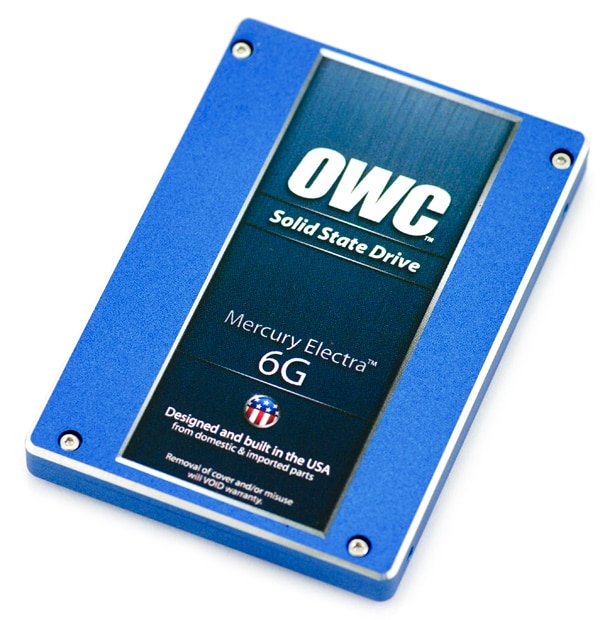
OWC Mercury Electra 6G Specs
- SF-2281 Processor
- IMFT 25nm Asynchronous NAND
- SATA 6Gb/s Interface
- Sustained Sequential Read: up to 556MB/s, Sustained Sequential Write: up to 523MB/s
- 60,000 4K IOPS
- 3-Year Warranty
Design and Build
The body of the OWC Mercury Electra is an all-metal design, painted metallic blue, with a machined edge circling the top of the drive. The model sticker on top of the drive has been updated from past models; now a full-gloss sticker with the OWC brand prominently displayed with the Mercury Electra name. OWC also makes sure to use the label to point out their drives are designed and built in the USA, which is pretty rare in the tech market.
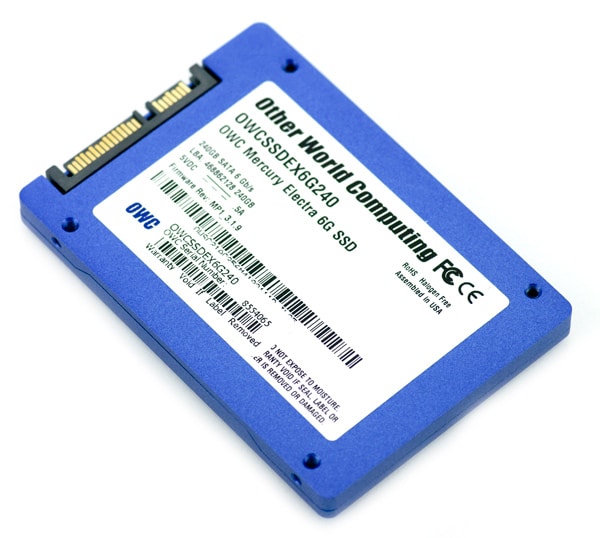
The bottom of the drive is more down to earth, with the detailed information about the drive listed, including the serial number, model number, firmware revision, and drive size specifics. The Electra also includes lower mounting holes, which are part of the 2.5-inch drive standard.
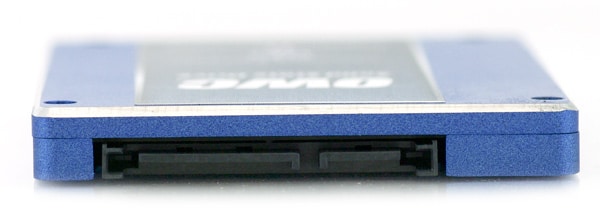
The sides are standard, with the case seam and ground top-cover border both visible. The cut top edge looks pretty cool, reflecting light and color depending on what angle you look at the drive from.

On the front the Electra has the SATA power and data connection, with no service pins visible. Overall the look and feel is pretty impressive. Not that looks matter a great deal when it comes to selecting an SSD, but there’s something to be said for a case design that’s sturdy and visually appealing.
Disassembly
Before I go into the steps on taking apart the Mercury Electra 6G, popping the drive open will void the warranty. The drive includes warranty voiding stickers over the screw holes located on top of the drive.
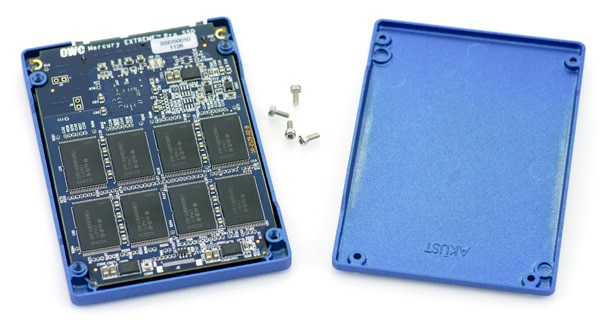
Taking the top cover off the Electra 6G is as easy as removing four Allen head screws and lifting the top plate off. With the cover removed the circuit board inside is free to be taken out as well.
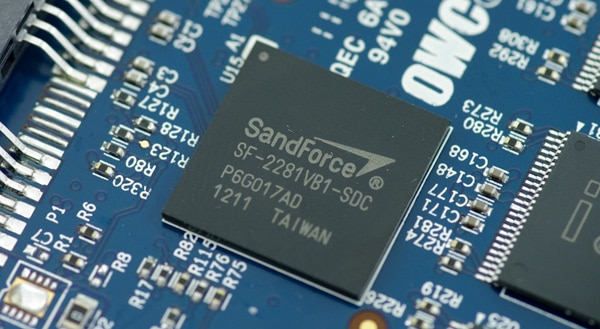
The OWC Mercury Electra 6G is powered by the SandForce SF- 2281VB1-SDC processor and paired up with sixteen pieces of Intel asynchronous 25nm NAND.
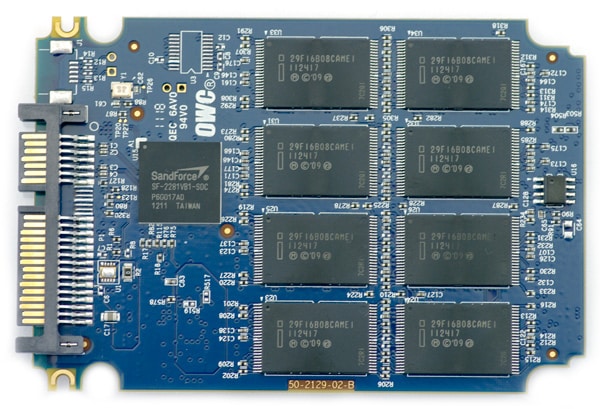
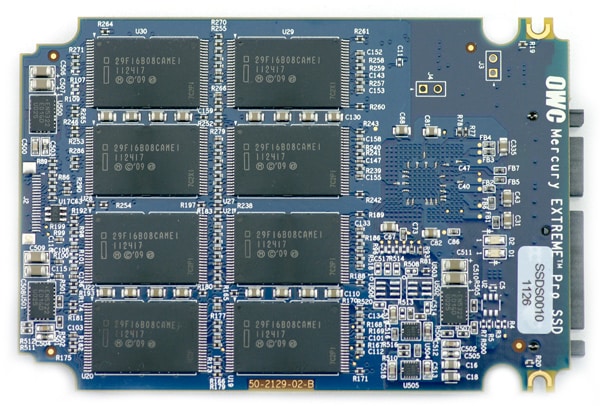
Synthetic Benchmarks
The OWC Mercury Electra 6G is to the Mercury Extreme 6G as what the Agility 3 is to the Vertex 3. Offering a step down in NAND to lower costs, the Electra is able to offer most of the speed of the Extreme, but for a more mainstream audience.
To start of we begin with a standard 2MB sequential transfer test to measure the straight line performance of each drive. All of these speeds are sustained over a period of one minute.
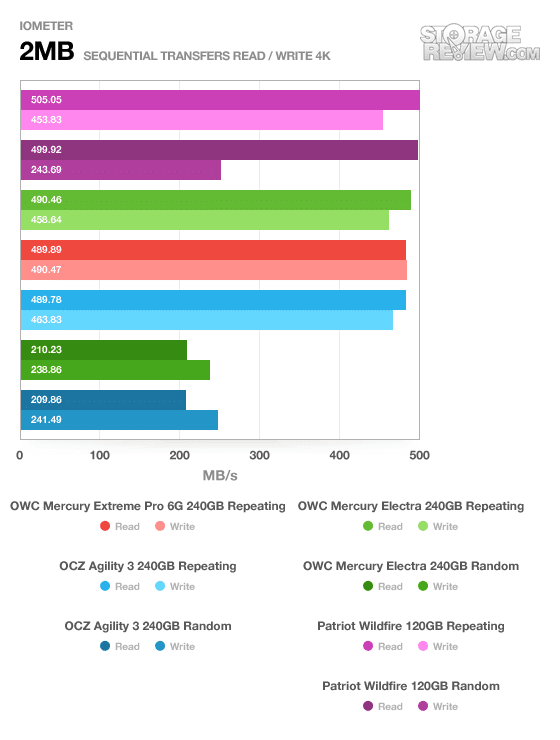
With repeating data the Electra clocked in with 490MB/s read and 458MB/s write which puts it solidly in the middle of the pack of SATA 6Gb/s SandForce models. Switching to a more stressful random/incompressible data transfer the speeds lowered to 210MB/s read and 238MB/s write… just about in parity with the OCZ Agility 3.
Our next test changes to 2MB random transfers, which for SSDs is still a very easy activity to perform with no moving parts to slow down access times.
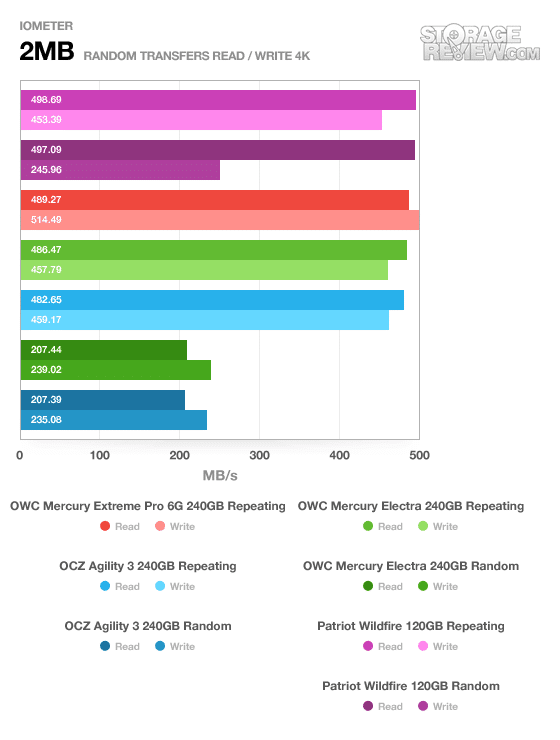
The Electra came in on top of the Agility 3 again, measuring 486MB/s read and 457MB/s write with repeating data. Changing to incompressible data, the drive slowed down to 207MB/s read and 239MB/s write.
In our random 4K transfer test using IOMeter, we look at how well each SSD performs at accessing very small packets of data in a completely random setting. With this first batch of tests performed at a queue depth of 1, all of these numbers will be lower than manufacturers’ claims.
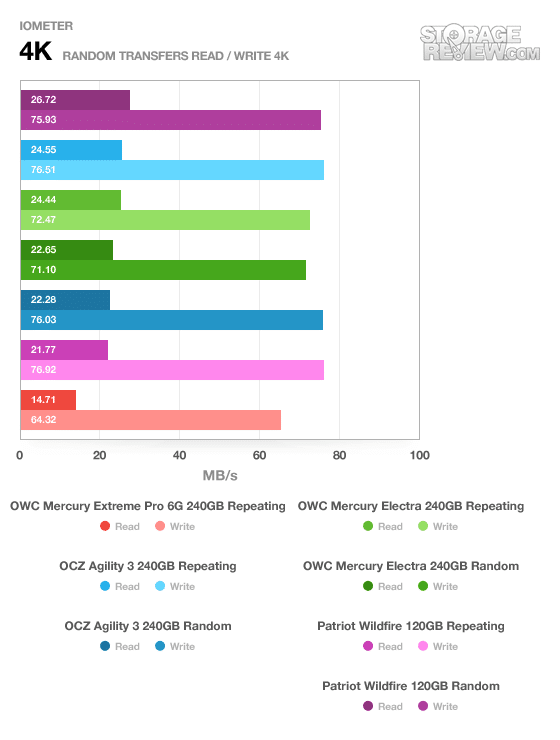
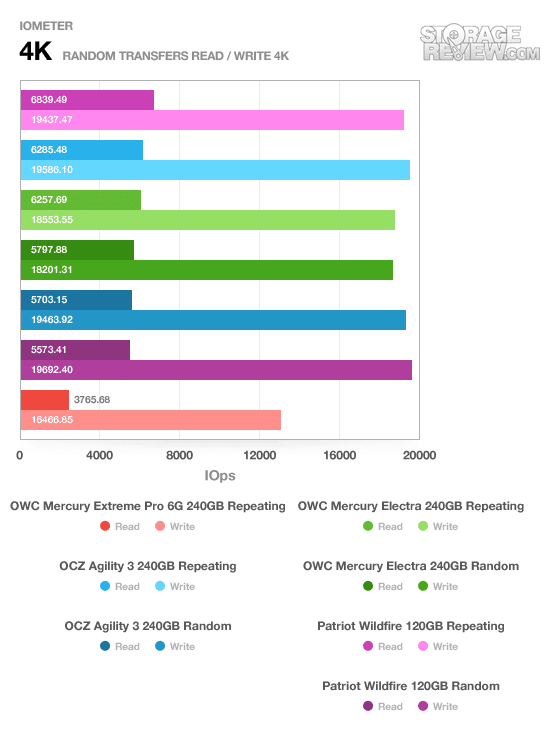
In the first stage of our 4K testing the Electra came in towards the bottom using repeating data, but had the strongest 4K read speed with incompressible data. With that said it did have some trouble keeping up in 4K write speeds compared to the others.
To gauge how well the SSDs perform under stress, our next section covers 4K read and write speeds over a ramped scale with queue depths starting at 1 and ending at 64. Each level is tested for 30 seconds with no recovery period as the scale moves up.
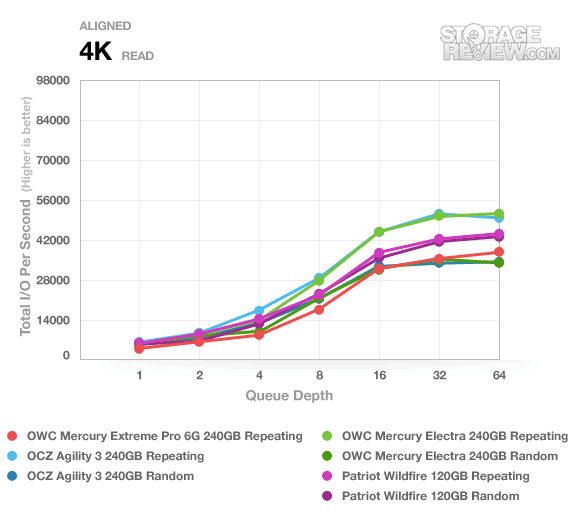
Both the OWC Mercury Electra 6G and OCZ Agility 3 lead the 4K read test, peaking out at roughly 52,000 IOps. Both performed similarly with random data, this time reaching 35,000 IOps.
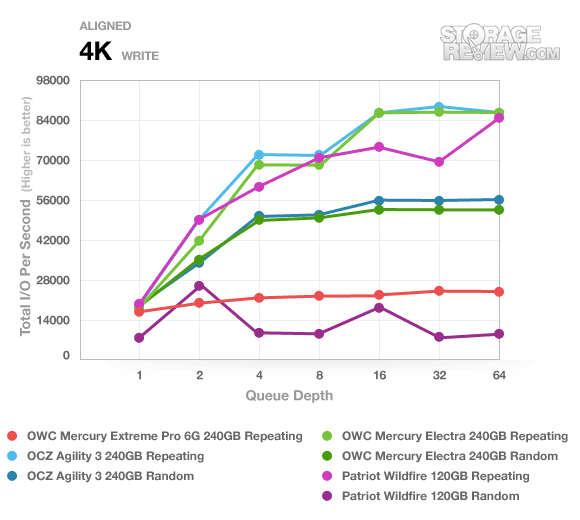
The write portion of the test showed the OWC and OCZ asynchronous NAND SSD offerings neck and neck in speeds. On the very top of the chart, the Electra reached an impressive 85,690 IOps with repeating data and 55,000 IOps with incompressible random data.
The OWC Mercury Electra slipped just slightly behind in our initual 4K write tests, putting its latency numbers below the other drives. In the grand scheme of things, most users wouldn’t be able to tell the difference between 0.051ms and 0.053ms, although it is worth noting that it could be a firmware difference between each of the drives.
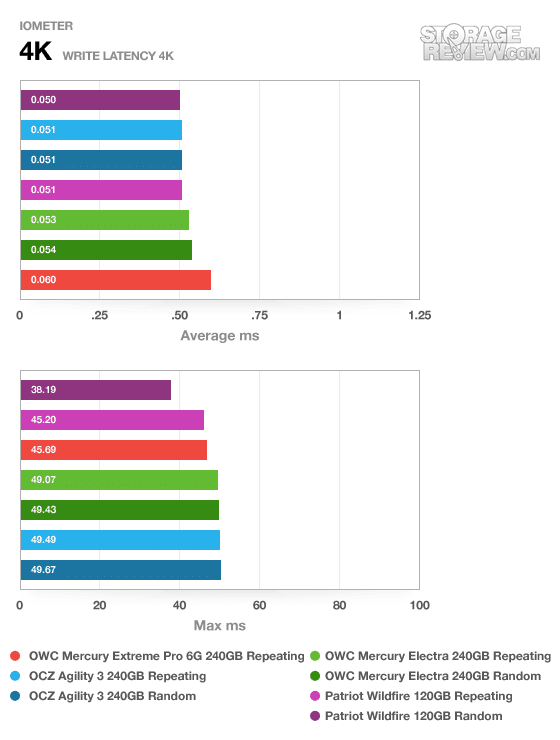
Using CrystalDiskMark with a random dataset, the OWC Mercury Electra 6G scored slightly higher numbers than in our incompressible IOMeter tests, which came in about 100MB/s slower. One significant difference is the duration of both of these tests, with IOMeter having a longer test duration.
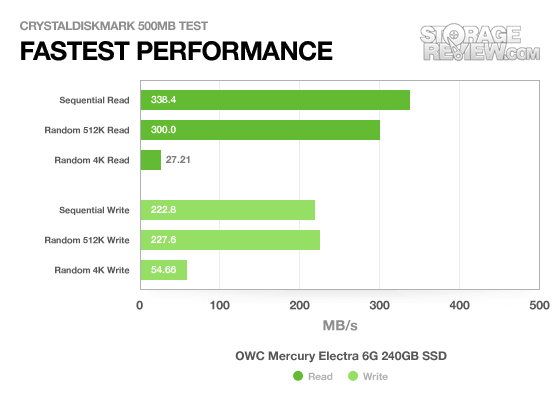
The last stage of our synthetic benchmarks covers IOMeter server profile tests. Performed in similar fashion to our ramped 4K read and write tests, these server profile benchmarks are a great way to see how well each SSD copes with continuous read/write loads. Each test lasts for a total of 8 minutes, with no resting period in-between each ramp in queue depth.
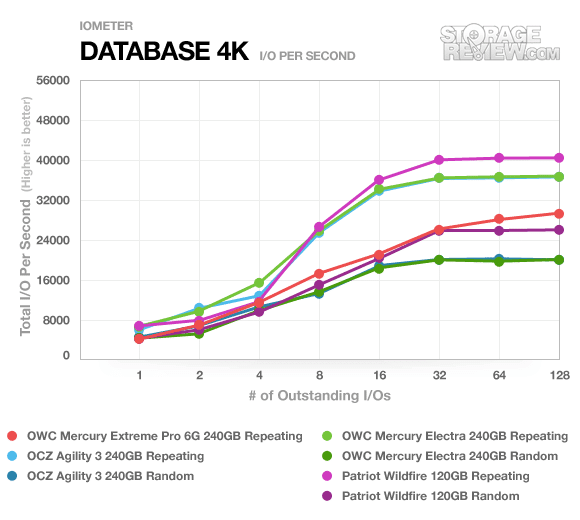
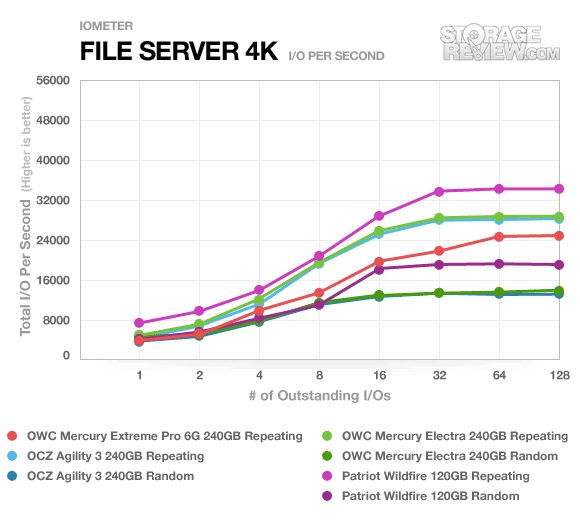
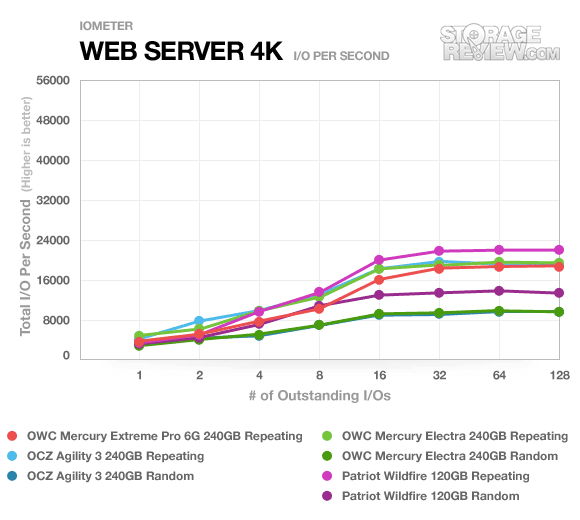
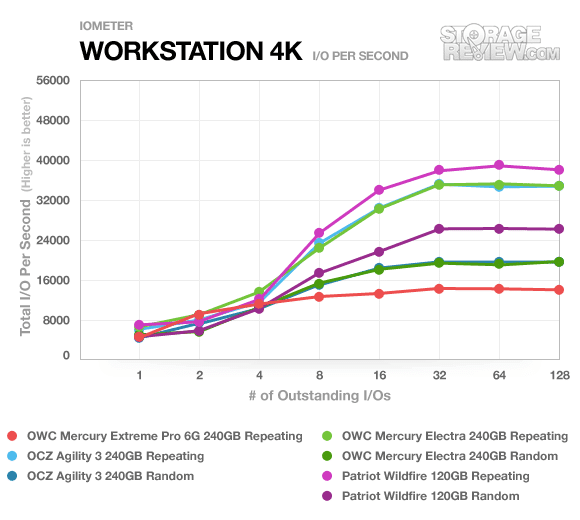
Real-World Benchmarks
If you are new to StorageReview, one thing we try to focus on is how any given drive might perform under real-world conditions. For the average user, trying to translate high random 4K write speeds into an everyday situation is pretty difficult. It also doesn’t make sense to assume that a drive with very high sequential speeds is going to perform great in the real-world if it can’t cope with mixed random activity. To really see how drives perform under normal work-loads you need to record the exact traffic being passed to and from the device, and then use that to compare drives against one another. For this reason we turned to our StorageMark 2010 traces, which include HTPC, Productivity, and Gaming scenarios to help our readers find out how well a drive might perform under their conditions.
We stacked the OWC Mercury Electra 6G up against the OCZ Agility 3, Patriot Wildfire, as well as included the original OWC Mercury Extreme Pro 6G which was tested on our older test bench for reference only. The primary head to head competition for this drive though is the 240GB Agility 3, offering the same NAND capacity and configuration.
The first real-life test is our HTPC scenario. In this test we include: playing one 720P HD movie in Media Player Classic, one 480P SD movie playing in VLC, three movies downloading simultaneously through iTunes, and one 1080i HDTV stream being recorded through Windows Media Center over a 15 minute period. Higher IOps and MB/s rates with lower latency times are preferred. In this trace we recorded 2,986MB being written to the drive and 1,924MB being read.
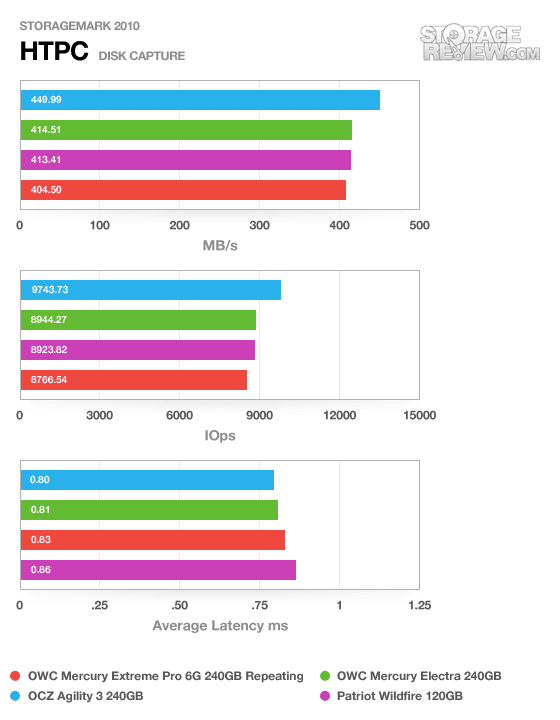
With its strong synthetic benchmark scores, it was surprising to see the Electra slipping behind the OCZ Agility 3 by 8% in our HTPC trace. It was still able to maintain a very small lead over the 120GB Wildfire, but it wasn’t a perfect apples to apples comparison given the differences in flash configuration.
Our second real-life test covers disk activity in a productivity scenario. For all intents and purposes this test shows drive performance under normal daily activity for most users. This test includes: a three hour period operating in an office productivity environment with 32-bit Vista running Outlook 2007 connected to an Exchange server, web browsing using Chrome and IE8, editing files within Office 2007, viewing PDFs in Adobe Reader, and an hour of local music playback with two hours of additional online music via Pandora. In this trace we recorded 4,830MB being written to the drive and 2,758MB being read.
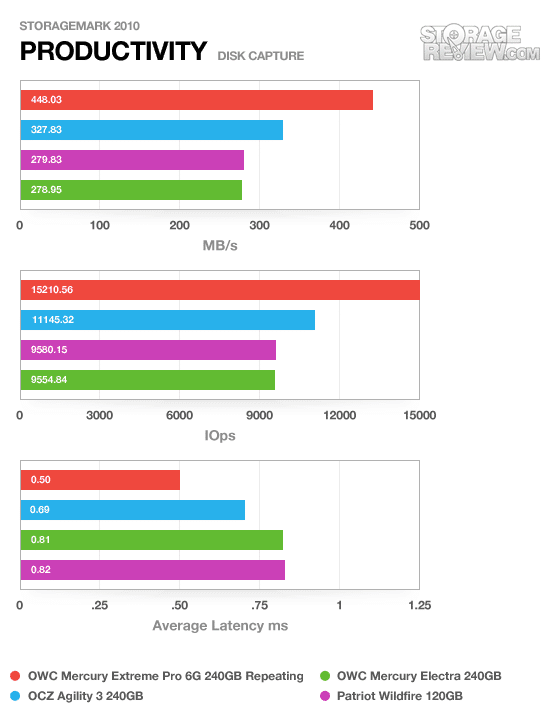
The Electra fell behind again in our productivity, this time by 15%, again staying neck and neck with the Wildfire. All of these drives still performed well under the synchronous NAND equipped Mercury Extreme Pro 6G.
Our third real-life test covers disk activity in a gaming environment. Unlike the HTPC or Productivity trace, this one relies heavily on the read performance of a drive. To give a simple breakdown of read/write percentages, the HTPC test is 64% write, 36% read, the Productivity test is 59% write and 41% read, while the gaming trace is 6% write and 94% read. The test consists of a Windows 7 Ultimate 64-bit system pre-configured with Steam, with Grand Theft Auto 4, Left 4 Dead 2, and Mass Effect 2 already downloaded and installed. The trace captures the heavy read activity of each game loading from the start, as well as textures as the game progresses. In this trace we recorded 426MB being written to the drive and 7,235MB being read.
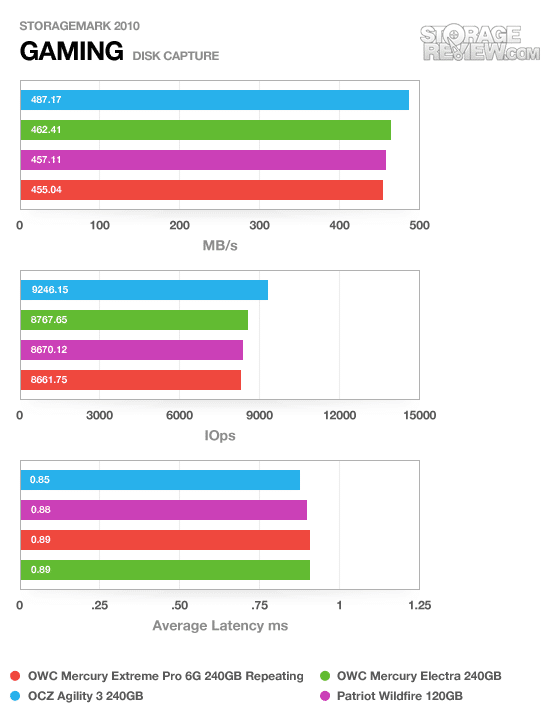
In the third and final trace, the difference in speed between the Agility 3 and Electra 6G narrowed to just 5%. The Electra came in on top of the Wildfire, with an average transfer speed of 462MB/s.
Power Consumption
To measure the power consumption of the OWC Mercury Electra 6G, we put it through the same IOMeter tests that we performed at the start of this review, and measured the power used in serial with the drive. We included both repeating and compressible write figures, since SandForce-based SSDs have to perform much less work when writing a compressible pattern to the drive.
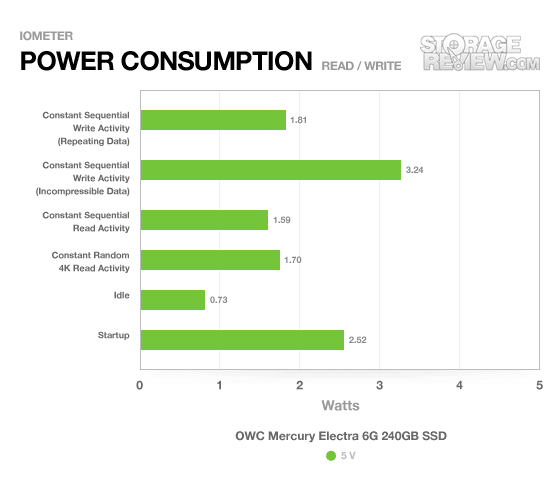
The Electra 6G consumed 1.81 watts of power when writing a repeating pattern to the drive, which was slightly higher than 1.50 watts we measured on the Agility 3. When switched to incompressible data the usage increased to 3.24 watts. Constant and random read activity varied between 1.59 and 1.70 watts, with idle coming in at 0.73 watts. These were on about 0.40 watts higher than the Agility 3 in the equivalent tests.
Warranty
The OWC Mercury Electra 6G comes backed with a three-year warranty, which is matched by other brands in the SSD market. Intel and OWC offer longer five-year warranties on select models, which from the OWC side includes the higher-end Mercury Extreme Pro 6G model. Another perk of buying this drive from OWC, is it currently supports a 30-day money-back guarantee.
Conclusion
The OWC Mercury Electra 6G comes to the market as a mainstream alternative to the faster and more expensive Mercury Extreme Pro 6G. Differentiated by asynchronous versus synchronous NAND initially (now toggle NAND is used in the ME Pro 6G), the Electra is able to come in at a lower price-point, though you do sacrifice incompressible write speeds. Right now the difference in price between the 240GB models is $90, with the Electra 240GB positioned at $459.
Overall we were pleased with the performance of the Electra 6G. It performed well in the synthetic tests, but it did slip behind the OCZ Agility 3 which is its closest competitor when it comes to our real world benchmarks. Some of these differences we feel are related to firmware, since from a hardware standpoint they both offer nearly identical components.
Even so, there comes a point where a few percentage points separating SSD performance speeds don’t really translate into “felt” speeds by the user. So we have to take into consideration other factors when making a buying decision. In this case, OWC tosses in their 30-day return policy, the feel-good US assembly and a solid reputation. OWC is even getting more competitive on price, the Electra is within a few dollars of the Agility 3 in every capacity. Given all “extras” we can easily recommend the Electra for mainstream SSD buyers who want great performance.
Pros
- 30-day money back guarantee
- Good design and build
- Higher 4K IOPS than advertised (peaked at 85,000)
Cons
- A touch slower than competition in real world benchmarks
Bottom Line
The OWC Electra 6G SSD hit most of the points we aim for with a mainstream SSD. It offers very good performance in most benchmarks and offers a very competitive starting price. Factor in the OWC 30-day guarantee and nice build quality – OWC has a very good drive on its hands.
